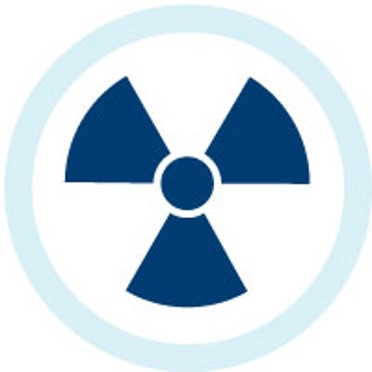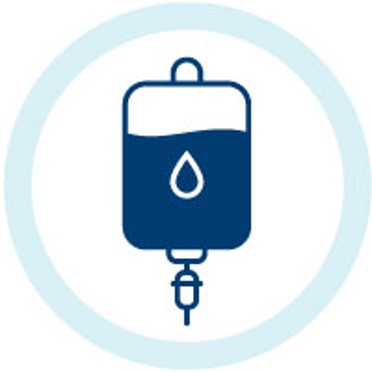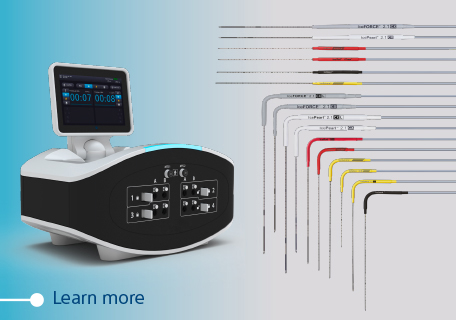Medical Specialties > Interventional Radiology > Ablation Solutions > Cryoablation Indications > Lung Tumours
Lung Tumours
Lung cancer is the major cause of cancer death for both men and women, making up almost 25% of all tumour deaths.1 Globally, it has been estimated by The World Health Organization (WHO) that lung cancer causes 1.59 million deaths per year (71% caused by smoking).2
Lung Tumours can be divided into3:
- Primary Lung Cancer: the tumour originates in the lung – in particular, it can develop from the cells that form the bronchi, bronchioles and alveoli;
- Secondary Lung Cancer: the cancer originates in another part of the body and spreads into the lung.
There are two main types of primary lung cancer:


Subtypes
Tumour Subtype |
Incidence (per 100,000 per year) |
Description |
Use of CA |
||
Non-small cell lung cancer (NSCLC) |
Adenocarcinoma (ADC) (malignant) |
17.9 A (40% of all lung cancers) B |
Lung adenocarcinoma starts in mucus-producing glandular cells, and it often develops in smaller airways, such as the alveoli. It is more common in women and young people (20-46). C |
Recent studies report percutaneous image-guided cryoablation of lung cancer as a minimally invasive procedure that is a particularly effective curative treatment of medically inoperable early-stage lung cancer and for tumour debulking in advanced-stage lung carcinoma. I, L The safety and the effectiveness of the cryoablation procedure to treat central lung tumours (primary and secondary) have been proven in multiple studies. K, L It has been demonstrated that the treatment of patients with stage IIIB/IV NSCLC with cryoablation has the advantage of decreased intra-procedural pain compared with microwave ablation. M |
|
Squamous cell carcinoma (SCC) (malignant) |
13.3 A (25–30% of all lung cancers) B |
Squamous cell carcinoma (SCC) usually develops in the flat cells that cover the medium-large airways, close to the lung’s centre. It is more often associated with smoking than other types of NSCLS. E, F |
|||
Large cell carcinoma (LCC) (malignant) |
3.1 A (10–15% of all lung cancers) B |
Large cell carcinoma is a rare type of cancer that can appear in different areas of the lung, usually in the periphery. It generally tends to grow and spread quickly. It is more common in men. G |
|||
Small cell lung cancer (SCLC) (malignant)
|
6.0 A (10% to 15% of all lung cancers) D |
Small cell lung cancer develops in the bronchi of greater diameter, is made up of small cells and usually occurs in smokers; it is very rare in those who have never smoked. It is a very aggressive cancer that tends to spread rapidly. H |
A case study reports the effective use of the cryoablation treatment, combined with low-dose chemotherapy, to treat a patient with unresectable small cell lung cancer. The procedure made it possible to have more than 7 years of survival and a great quality of life for the patient. N |
||
Treatment options
There are a number of treatment options for lung cancer. The therapeutic approach varies according to the patient's condition, the stage of the cancer, the molecular characteristics, and, above all, the histology of the tumour.
The most common treatments for both non-small cell lung cancer (NSCLC) and small cell lung cancer (SCLC), are6:






Targeted therapies and angiogenesis inhibitors can be also used to treat NSCLC.6
An increasing number of physicians are using cryoablation as a curative and therapeutic treatment for lung tumours; the safety and efficacy of this approach has been demonstrated by a number of clinical studies and investigations.7,8
Clinical Results – Why Cryoablation?
Discover Cryoablation for Lung Tumours
“Cryoablation allows technically challenging lung tumours tobe treated safely and effectively.”
Dr Thierry de Baere - Gustave Roussy Cancer Institute, Villejuif, France
View Prof Thierry de Baere’s Case study on lung tumour cryoablation
Cryoablation has been demostrated to be safe in the treatment of lung tumours and a viable alternative to surgery for certain patients. This procedure has not only been shown to effectively maintain pulmonary functions, but it also provides good overall long-term survival (5-year overall survival: 67.8%)7 for patients, with minimal complications and short hospital stay (1.6 days).7
Discover Cryoablation for Metastatic Lung Tumours
“Cryoablation is a safe and effective treatment for pulmonary metastases with preserved quality of life following intervention."
de Baere T et al. 2015
According to the American Lung Association (ALA), the overall 5-year survival rate for patients with metastatic lung tumours is 18.6%.9
The recent ECLIPSE Study has shown that cryoablation is an effective treatment for metastatic lung tumours, providing long-term tumour control (79.2% at 5 years) and good survival rate (46.7% at 5 years).10
- ECLIPSE is the only metastatic lung tumour study with 5-year follow-up10
- 78.2% patients were free from local progression at 5 years10
- Overall local tumour control rates: 87.9% and 79.2% per tumor, and 83.3% and 75.0% per patient, at 3 and 5 years10
- Disease specific survival rate: 74.8% at 3 years and 55.3% at 5 years10
- Overall survival rate: 63.2% at 3 years and 46.7% at 5 years10
Metastatic lung tumours have a major impact on patients, representing a life-threatening condition that can be hard to treat successfully.11
The recent SOLSTICE Multicentre Study of metastatic lung tumours has demonstrated that percutaneous cryoablation is a safe and effective treatment for pulmonary metastases which results in a high rate of survival (86.6%/24 months).12
- SOLSTICE Study: N= 128 patients, 167 procedures, 224 lung metastases treated with cryoablation12
- 12 month follow-up: Initial local tumor efficacy (local recurrence-free survival) was achieved in 172/202 tumors (85.1%)12
- 24 month follow-up: Initial local tumor efficacy (local recurrence-free survival) was achieved in 139/180 tumors (77.2%)12
- Overall survival rates: 97.6% after 12 months and 86.6% after 24 months12
- Overall treatment efficacy: 77% primary and 84% secondary treatment efficacy at minimum of 24 months follow-up12
Our Solutions
Cryoablation is a minimally invasive treatment that uses extreme cold to freeze and destroy diseased tissue, including cancer cells. We offer a broad portfolio of Systems and Needles, that, thanks to the latest technology, provide an effective treatment for tumours.
Learn more about our solutions




















